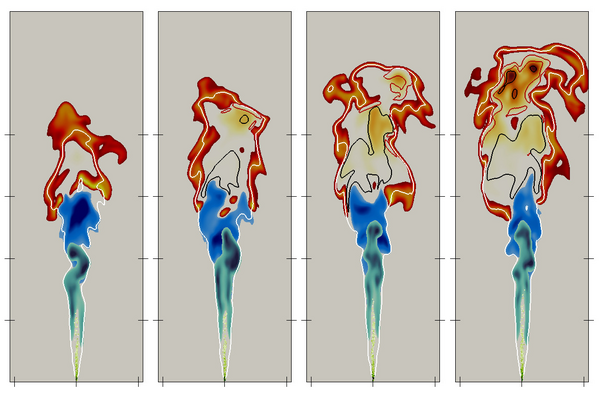Spray combustion
Project participants: Ahmad Hadadpour, Shijie Xu, Shenghui Zhong, Mehdi Jangi, Hesam Fatehi, Xue-Song Bai
Background
As an important source of energy conversion, combustion engines are widely used in cars, ships, and aircrafts. Spray combustion is the basic process in combustion systems with liquid fuels. In order to improve the efficiency of the combustion systems and to reduce greenhouse gas and pollutant emissions, advanced spray combustion strategies, such as multiple-injection, dual-fuel combustion and direct injection spark ignition (DISI) are proposed. Figure 1 shows the vapor fuel clouds in a two-injection spray flame [1]. A better understanding of the underlying physical processes in these combustion strategies is important for the development of these strategies and application of them into practical combustion systems.

Project goals
- To understand the ignition and flame propagation in spray combustion;
- To optimize the injection strategies in multiple-injection combustion;
- To develop numerical simulation models for cost-effective prediction of spray combustion process.
Sample Results
In order to describe the two-phase flow in spray combustion, the Eulerian-Lagrangian approach is applied within the Large Eddy Simulations (LES) framework. The Eulerian gas phase is governed by spatially filtered Navier-Stokes equations, while the liquid phase is described by Lagrangian particle tracking (LPT) approach using a large number of parcels.
For flame/turbulence interaction during the vapor fuel oxidation, three different approaches are developed and validated,
- Eulerian stochastic field transported probability density function (TPDF-ESF)
- Presumed PDF based stochastic reactor model (StoR)
- Flamelet-Generated Manifold (FGM) model is used to accommodate the detailed chemistry.
A chemistry coordinate mapping (CCM) method with finite-rate chemistry is developed to speed up the TPDF-ESF and the SToR models. In the CCM approach, the integration of the stiff chemical reaction rates is done in a low-dimensional chemical phase space, and the results are mapped back to the mesh points in the physical space. This approach can speed up the time-consuming integration of the chemical reaction rates by a factor of 10.
One of our current focuses is on improving the FGM model by replacing the presumed PDF submodel with an ESF model.
Figure 2 illustrates the injection, evaporation, mixing and ignition processes in n-heptane/methanol dual-fuel spray combustion. The liquid fuel droplets ejected from nozzle are shown as the grey spheres. The liquid droplets break up and evaporate into gaseous fuel vapor. The white line shows the stoichiometric mixture. The gaseous fuel is oxidized to heptyl-peroxide radicals, which are denoted with green color. It can be seen that the heptyl-peroxide radicals are oxidized downstream in a low temperature region, followed by formaldehyde (blue color), a key intermediate product before ignition. Around the stoichiometric mixture hydroxyl radicals (OH) are shown, which indicates the reaction zone of the lifted spray flame.

Sample publications
- A. Hadapour, M. Jangi, K.M. Pang, and X. S. Bai, "The role of a split injection strategy in the mixture formation and combustion of diesel spray: A large-eddy simulation," Proceedings of the Combustion Institute 37 (4), 4709-4716 (2019).
- KM Pang, M Jangi, XS Bai, J Schramm, JH Walther, P Glarborg, Effects of ambient pressure on ignition and flame characteristics in diesel spray combustion, Fuel 237:676-685, 2019.
- K.M. Pang, M. Jangi, X.S. Bai, J. Schramm, J. H. Walther, Modelling of diesel spray flames under engine-like conditions using an accelerated Eulerian Stochastic Fields method, Combustion and Flame, 193, 363-383, 2018.
- A. Hadadpour, M. Jangi, X.S. Bai, The effect of splitting timing on mixing in a jet with double injections: A large-eddy simulation study, Flow Turbulence and Combustion, 101:1157–1171, 2018.
- A Hadadpour, M Jangi, XS Bai, Jet-jet interaction in multiple injections: A large-eddy simulation study, Fuel 234, 286-295, 2018.
